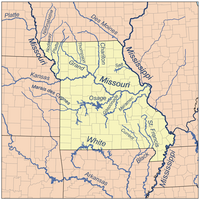| Current | |
|---|---|
 Current River near Doniphan | |
 Map of major Missouri Rivers | |
| Location | |
| Country | United States |
| State | Missouri, Arkansas |
| Region | Ozark Plateau, Mississippi Alluvial Plain |
| Cities | Van Buren, Doniphan, Missouri |
| Physical characteristics | |
| Source | Pigeon Creek Montauk Spring |
| • location | Montauk State Park, Dent County, Ozark Plateau, Missouri |
| • coordinates | 37°27′36″N 91°41′00″W / 37.46000°N 91.68333°W[1] |
| • elevation | 935 ft (285 m)[2] |
| Mouth | Black River |
• location | Pocahontas, Arkansas, Randolph County, Mississippi Alluvial Plain, Arkansas |
• coordinates | 36°15′11″N 90°54′45″W / 36.25306°N 90.91250°W[1] |
• elevation | 243 ft (74 m)[1] |
| Length | 184 mi (296 km) |
| Basin size | 2,641 sq mi (6,840 km2) |
| Discharge | |
| • location | Doniphan, Missouri[3] |
| • average | 2,772 cu ft/s (78.5 m3/s)[3] |
| • maximum | 130,000 cu ft/s (3,700 m3/s) |
| Basin features | |
| Tributaries | |
| • left | Sinking Creek, Little Black River, Welch Spring |
| • right | Big Creek, Jacks Fork, Big Spring |
The Current River forms in the southeastern portion of the Ozarks of Missouri and becomes a 7th order stream[4] as it flows southeasterly out of the Ozarks into northeastern Arkansas where it becomes a tributary of the Black River, which is a tributary of the White River, a tributary of the Mississippi River. The Current River is roughly 184 miles (296 km) long and drains about 2,641 square miles (6,840 km2)[4] of land mostly in Missouri and a small portion of land in northeastern Arkansas. The headwaters of the Current River are nearly 900 feet (270 m) above sea level, while the mouth of the river lies around 280 feet (85 m)[4] above sea level. The basin drains a rural area that is dominated by karst topography, underlain by dolomite and sandstone bedrock with a small area of igneous rock southeast of Eminence, Missouri. The annual daily mean discharge of the river near Doniphan, Missouri is 2,815 cubic feet (79.7 m3) per second.[4] In 1964, over 134 mi (160 km) of the upper course of the river and its tributaries were federally protected as the Ozark National Scenic Riverways,[5] the first national park in America to protect a river system.
- ^ a b c U.S. Geological Survey Geographic Names Information System: Current River (Ozarks)
- ^ U.S. Geological Survey Geographic Names Information System: Montauk Spring
- ^ a b USGS 07068000 Current River at Doniphan, MO
- ^ a b c d Inventory and Assessment for Current River Watershed, Missouri Department of Conservation
- ^ http://www.nps.gov/ozar/ National Park Service